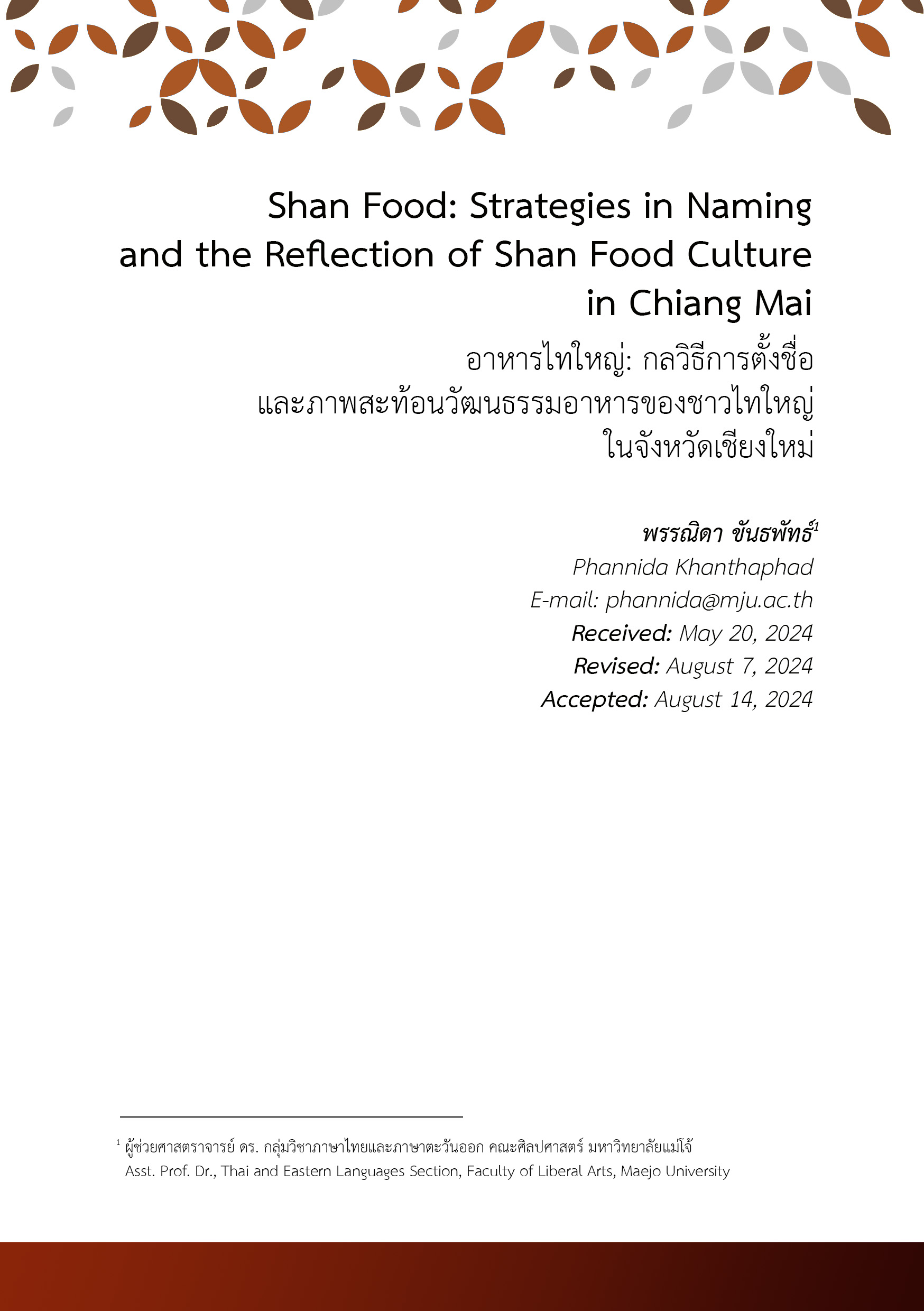Shan Food: Strategies in Naming and the Reflection of Shan Food Culture in Chiang Mai อาหารไทใหญ่: กลวิธีการตั้งชื่อและภาพสะท้อนวัฒนธรรมอาหารของชาวไทใหญ่ ในจังหวัดเชียงใหม่
Main Article Content
Abstract
This research investigated the naming strategies for Shan food and the reflection of the food culture of Shan people in Chiang Mai. From the 287 food names analyzed by using the concepts of cognitive semantics and anthropological linguistics, this research found that the Shan food names consisted of those with direct meanings and metaphorical meanings. The Shan food names with direct meanings when classified by the initial words of the food names, they reveal five structures as follows: 1) ingredient 2) food type 3)cooking method 4)food characteristic and 5)proper name. As for the metaphorical words, they can be classified into two forms: fully-metaphorical meanings and semi-metaphorical meanings. They mostly referred to humans, animals, natural materials, objects, and supernatural things. Concerning the reflection of the Shan food names, most of them contained the words /khao/ (rice), /thua/ (bean), and /phak/ (vegetable), reflecting that Shan food culture heavily relied on these three ingredients, as the main ingredients of their daily cuisine.
Downloads
Article Details

This work is licensed under a Creative Commons Attribution-NonCommercial-NoDerivatives 4.0 International License.
References
Bangsut, S., & Arom, P. (2015). Deliciousness of Lanna: Cultural Heritage of Local Food. Bangkok: Sangdad.
Chiang Mai Rajabhat University. (2009). Tai Yai (Shan)_Thai Dictionary. Chiang Mai: Chiang Mai Rajabhat University.
Khomithin, A. (2005). A cognitive semantics study of food naming in Thai (Master's Thesis). Thammasat University , Bangkok.
Lakoff,G. (1987). Women Fire and Dangerous Things: What categories reveal about the mind. Chicago and London: The University of Chicago Press.
Lu, J. (2010). Naming Strateg and Metaphor in Thai and Chinese Languages (Master's Thesis). Kasetsart University, Bangkok.
Ongsakul, S. (2001). Lanna History (3rd ed.). Bangkok: Amarin.
Royal Institute. (2014). Linguistic Terms Dictionary (Applied Linguistics) (2nd ed.). Bangkok: Royal Institute.
Sao Tern Moeng. (1995). Shan_English Dictio nary. Maryland: DP Dunwoody Press.
The World Factbook. (2024). Explore All Countries – Burma. Retrieved July 25, 2024, from https://www.cia.gov/the_world_factbook/
countries/ burma/#people_and_society
Tuaycharern, P. (2001). The overview of language and linguistics studies (2th ed.). Bangkok: Thammasat University.
Wichasin, R. (2003). Knowing and Reading Shan Script. Chiang Mai: Department of Thai, Faculty of Humanity, Chiang Mai University.
Wongthai, N. (2016). The Study of the Chili Paste Names in 4 Regions of Thailand: The Reflection of Thai Living and Culture. Journal of Srinakharinwirot Research and Development (Humanities and Social Sciences Branch), 8(16), 88_100.


